The 6 Essential Types of Pots and Pans — and What to Cook in Each
Dotdash Meredith and Yahoo Inc. may earn commission or revenue on some items through the links below.
We rounded out the can't-miss cookware to stock your kitchen with, including our top picks in each category.
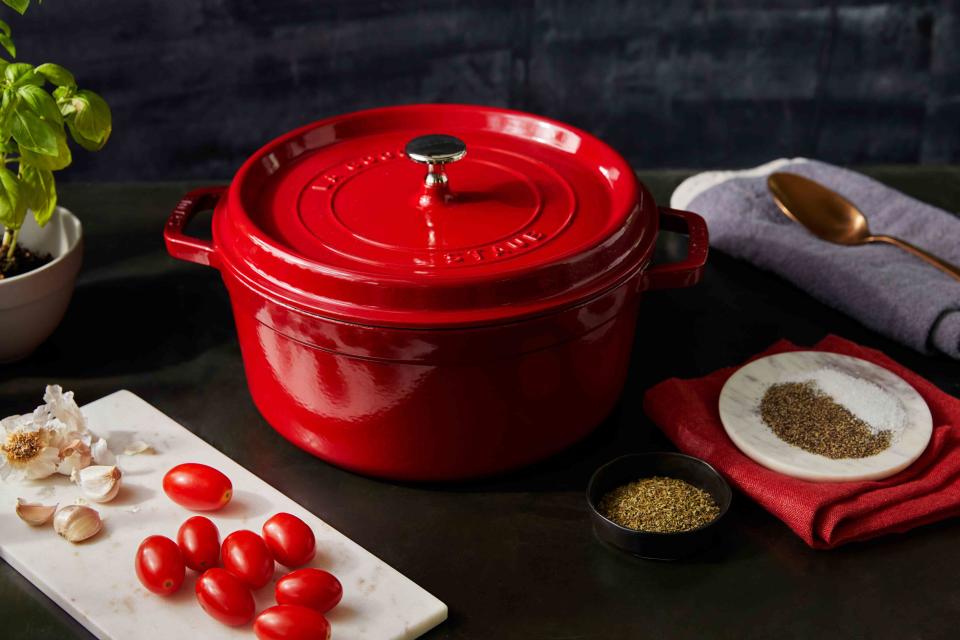
Food & Wine / Will Dickey
Each piece of kitchen equipment is as varied in its design and purpose as any other kind of tool, and if you’re outfitting an empty kitchen, it can be an investment as major as buying new furniture. Navigating the abundant variety of pots and pans on the market to figure out what you truly need is intimidating.
Out of all the pots and pans for sale today, we’re convinced there are six essential categories for prime functionality in the kitchen, many of which we’ve tested for ourselves. We aim to help you wade through the mess to find the best pots and pans based on the cooking you do in your own kitchen. We also called in expert chefs Emshika Alberini and Evan Hennessey for advice on utilizing cookware to your advantage. Below, you’ll find our tested and expert picks for a well-rounded kitchen fit for any and all tasks.
Skillet
A good skillet is your right hand when it comes to all-purpose cookware. Skillets are used more in the average kitchen than any other pot or pan, making it even more important that yours be both reliable and functional. They’re particularly versatile, good for everything from the obvious (like frying up a perfect egg) to more unconventional uses, such as making skillet cake or even perfectly grilling chicken. There are three materials to choose from primarily: stainless steel, nonstick, and cast iron. Each is best suited to specific methods of cooking. Stainless steel is the most versatile. Nonstick is best for delicate foods like pan-frying flaky fish. Cast iron works well with different heat sources to accomplish tasks inside of the oven or on the grill, meaning you can do everything from baking brownies to making crispy casseroles.
Our stainless steel pick: Made In Cookware Stainless Clad Frying Pan
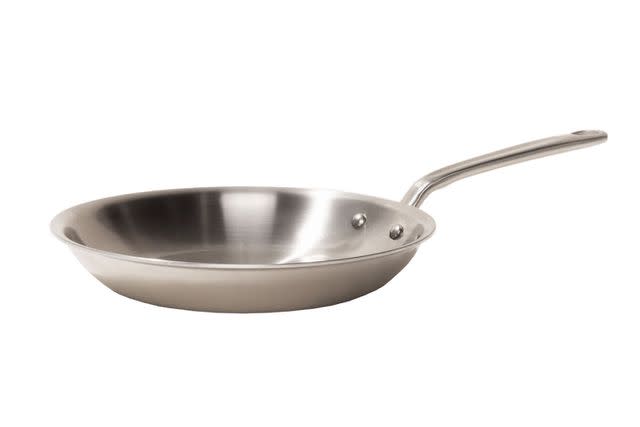
Made In
Our perfect stainless-steel skillet is incredibly durable, high value, and versatile. Chef Evan Hennessey — whose many accolades include being a 3-time Chopped Champion, a James Beard Award semi-finalist, and the chef/owner of Stages at One Washington and The Living Room — says very little beats heavy bottom stainless-steel clad pans as all-purpose skillets. He continues that stainless-steel skillets can prepare everything from searing a steak to something as simple as a grilled cheese to give that perfect toast. Made In Cookware 10-Inch Stainless Clad Frying Pan was our favorite choice through every test we ran, proving it has the range for working a range.
Price at time of publish: $109
Our nonstick pick: Made In Cookware Nonstick Frying Pan
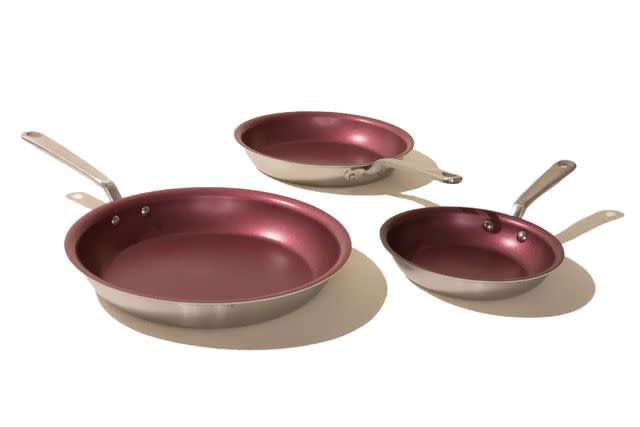
Made In
Nonstick pans are perfect for anyone cooking more delicate foods that easily stick to the pan. This includes not only fish filets but other fragile items, like a batch of crepes or a soft rolled omelet. Emshika Alberini, the owner of Chang Thai Cafe in Littleton, New Hampshire, says she uses nonstick pans for easy cooking tasks. “I love a nonstick pan for everyday use, such as making breakfast, or small cooking, such as sautéing vegetables or preparing a delicious sauce.”
Price at time of publish: $399
Our cast iron pick: Lodge Pre-Seasoned Cast Iron
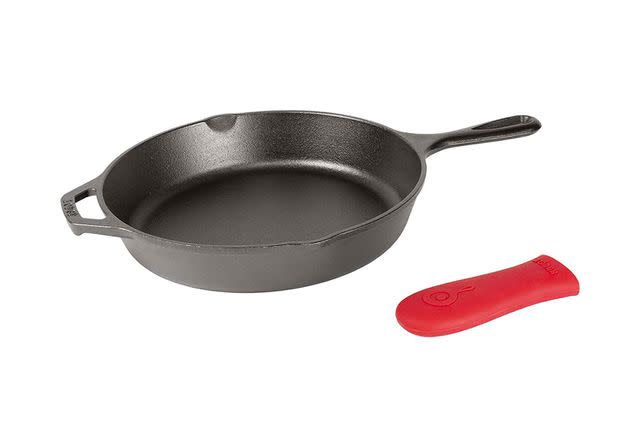
Amazon
Cast iron is built to last and is highly versatile. Still, having a pan that’s a good value is important, especially if you’re not already a regular cast iron user. The Lodge Pre-Seasoned Cast Iron skillet is our top pick for many reasons, but its price point and durability are certainly two of them. “Pick something, and you can figure out how to cook it in cast iron,” Hennessey says. “You can put it on the grill, over a fire, in a fire, take it camping, drop it down the stairs, and still make pancakes in it.”
Price at time of publish: $25
Dutch Oven
Despite their size and often misunderstood areas of expertise, Dutch ovens can serve myriad purposes in the average kitchen. Like the versatility of a cast iron skillet, a Dutch oven can be utilized on the stovetop or in the oven. Good for searing and slow cooking, Dutch ovens are also particularly skilled when it comes to heat retention and batch cooking, meaning they can be used for things like baking delicious bread, braising meats until tender, and simmering a perfect tomato sauce.
Our pick: STAUB Cast Iron Dutch Oven 5.5-Quart Round Cocotte
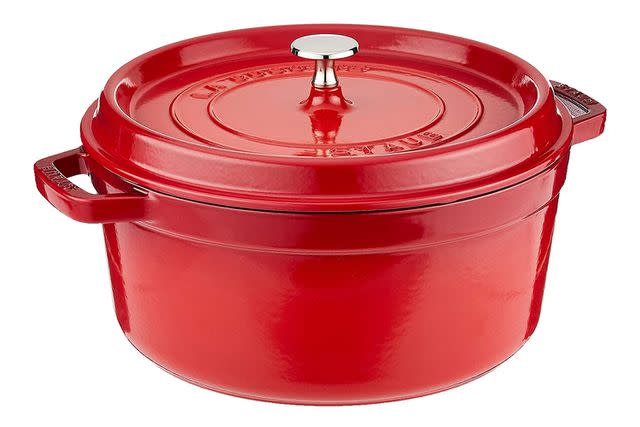
Amazon
Our pick for the best Dutch oven combines everything necessary for functionality and durability. The STAUB Cast Iron Dutch Oven 5.5-Quart Round Cocotte is practically indestructible and ready to last a lifetime, given the proper care and upkeep. While heavy and sturdy, the 5.5-quart size is a happy medium when it comes to the average home cook’s needs. If you will only own one, it’s best to avoid a Dutch oven that is too big to store easily or too small to get the job done. We also love its attractive and classic design — plus, we know you’ll pass it down at least one generation. Dutch ovens are large enough that many people prefer to give them a home on the stovetop, and with the STAUB’s color options, you’ll be able to match yours to your kitchen.
Price at time of publish: $299
Wok
Chef Alberini, who cooks with a wok both in her restaurant and at home, says the inherent versatility of a wok makes it a great tool for cooking pretty much everything. “They’re perfect for preparing a variety of dishes, such as stir fry and soups, as well as boiling noodles and other ingredients.” Finding the right size will depend on your stovetop's size, but comfortability of use is key. Alberini suggests measuring your stovetop before purchasing a wok: “Make sure that it is not too wide, heavy, or long.” When it comes to materials, carbon steel manages higher temperatures, giving your wok even more versatility. Alberini also prefers wooden-handled woks: “In my opinion, it’s more comfortable to hold,” she says.
Our pick: Craft Wok Traditional Hand Hammered Carbon Steel Pow Wok
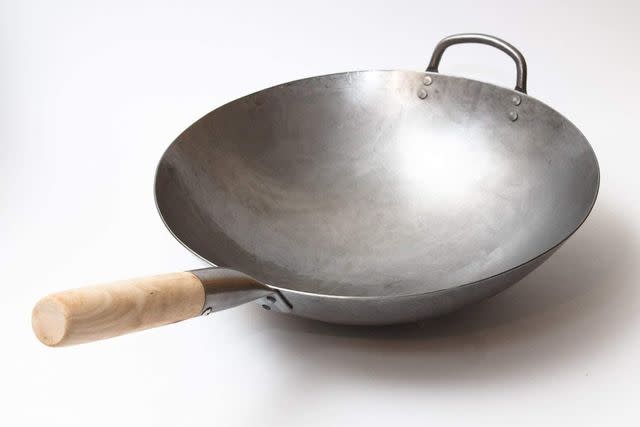
Amazon
The best wok we’ve found is carbon steel with a wood handle and a reasonable price point. Comfortable to hold, the perfect size, and durable, this piece of cookware is meant to accomplish any task while never fading in quality. The rounded bottom and 14-inch size are perfect for flipping and stirring with many tools. Whether you’re cooking up a fresh stir fry or a soup that packs a punch, a wok will quickly prove to be an essential tool in your kitchen.
Price at time of publish: $65
Stock Pot
A good stock pot is a must-have. And contrary to popular belief, you don’t need a pot that takes up an entire kitchen cupboard. “Look for something that can fit three chicken carcasses,” Hennessey recommends as the perfect size for a stock pot. “Hardly ever do you make more than that; if you do, you can do it in batches.” A taller pot will also make boiling pasta of any shape a little easier so the water can roll, according to Hennessey, and longer pasta goes all the way in when dry.
Our pick: All-Clad Specialty Stainless Steel 3-Piece Cookware Set
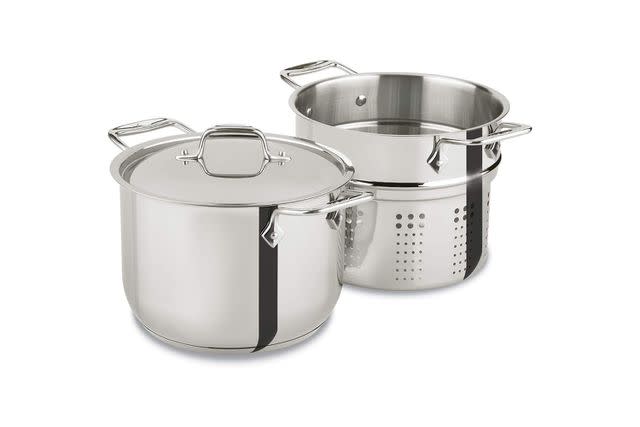
Amazon
This 3-piece set is a 6-quart capacity pot with a lid and a perforated insert. It’s perfect for pasta but can be used for anything from making homemade stock to steaming seafood. Made of heavy-gauge 18/10 stainless steel, it is practically invincible. Even so, All-Clad offers a lifetime warranty. It’s even oven-safe at every temperature. Who knew? (We did, and now you do, too!)
Price at time of publish: $100
Saucepan
While similar, saucepans and sauté pans are fundamentally different in terms of shape and function. Both are essential pieces of cookware for any home. As Chef Hennessey explains, “A saucepan has higher sides than a sauté pan and is better used for simmering or boiling liquids.” Saucepans can be made of stainless steel, which tends to be more durable, with even heating across the surface. With these, a better sear is possible. They can also go in the oven and endure very high temperatures. Plus, there’s no worry about damaging a nonstick coating. However, nonstick pans have the benefit of being remarkably easy to use and clean with ease.
Our stainless-steel pick: Tramonita Covered Sauce Pan with Helper Handle
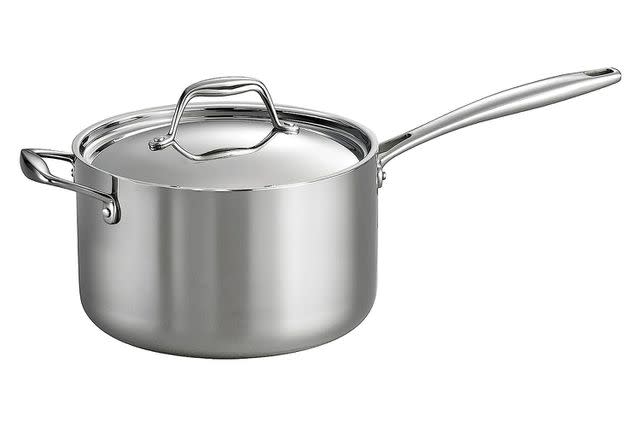
Amazon
A stainless-steel saucepan is such a mainstay in the kitchen, but it must be comfortable to use. The Tramonita Covered Sauce Pan with Helper Handle is a pan with a pleasantly shaped handle designed to support the cooking of sauces that require constant stirring and maintenance. Made of 3-ply stainless steel with aluminum, this saucepan offers reliable, even heat with a perfect performance at high temps. Cleanup is a breeze, which is excellent, considering one of the biggest downsides of stainless steel cookware is that it can be difficult to clean.
Price at time of publish: $75
Our nonstick pick: Made In Cookware Nonstick Saucepan
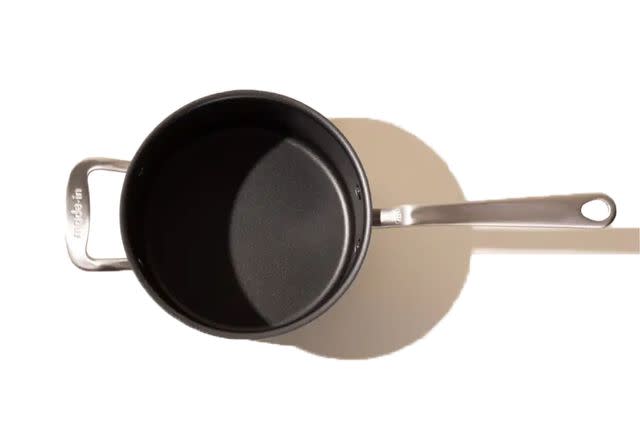
Made In Cookware
“I prefer nonstick and non-toxic cookware because I like very simple yet stylish pieces,” Alberini says. “I love lightweight and easy-to-clean products.” The Made In Cookware NonStick Saucepan was a clear winner to us, as is the case with many Made In products across our cookware tests. Nonstick cookware can lose its coating over time, rendering it unusable. This is why investing in a pan that will last is so important. This saucepan is durable and both dishwasher- and oven-safe (up to 800 degrees Fahrenheit).
Price at time of publish: $169
Sauté Pan
In contrast to the saucepan, a sauté pan is primarily used for high-heat cooking rather than simmering or boiling sauce and stocks. “Sautéing is cooking where you intend to flip,” says Hennessey. “It literally translates as “to jump” the food.” A sauté pan is particularly good for basting and other techniques that build flavor with constant movement. Typically, sauté pans have a low lip — “No higher than 1.5 inches,” notes Hennessey — and curved sides that make it easier to flip food with your wrist.
Our stainless steel pick: Tramonita Covered Deep Sauté Pan
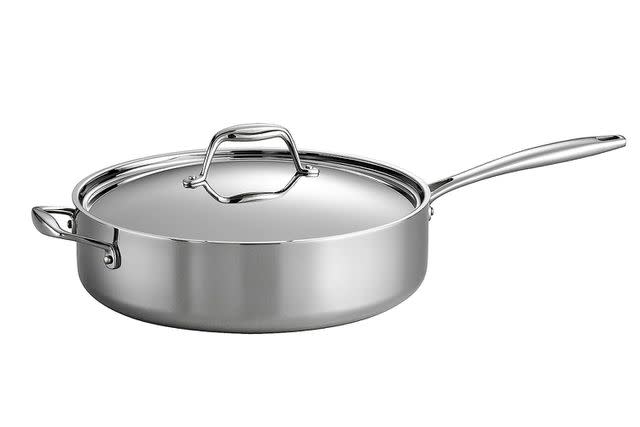
Amazon
Stainless steel may be the perfect material for a sauté pan. The material’s high heat tolerance means you can put a nice sear on meat before finishing it in the oven. We love the Tramonita Covered Deep Sauté Pan because you can do all this and still clean up without effort afterward. Cleanup requires just a spot of detergent and a sponge rather than the elbow grease some stainless steel cookware requires.
Price at time of publish: $96
Our nonstick pick: Made In Cookware Nonstick Sauté Pan
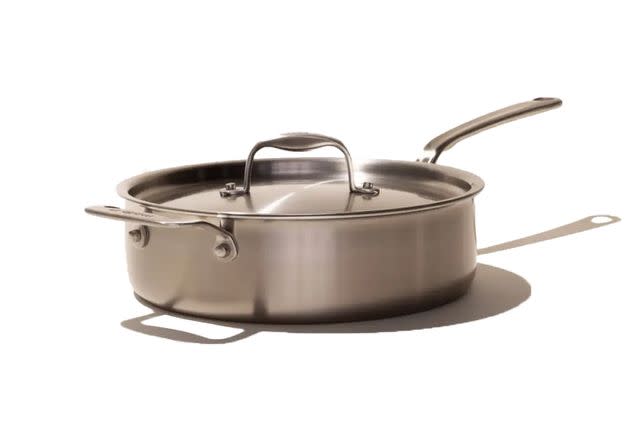
Made In Cookware
When designed and crafted for serious cooking, a nonstick sauté pan can be one of the most versatile pieces in a kitchen. When your nonstick sauté pan functions similarly to a stainless steel pan, the nonstick surface is conducive to building flavor. Made In Cookware Nonstick Sauté Pan has a heat tolerance and even surface that rivals all of its stainless-steel competitors. It’s a worthwhile investment based on durability alone. This pan won’t wear down anytime soon.
Price at time of publish: $169
Frequently Asked Questions
What material of cookware is best?
This depends on your cooking style and how you use each piece of cookware. Generally, stainless steel pots and pans are the most versatile. They tolerate very high heat, can be used in the oven, and conduct heat evenly across their surface, so there are no worries of cold or hot spots, even after much use. They’re built to be long-lasting, so a piece of stainless-steel cookware is a worthy investment.
Nonstick cookware is notoriously easy to clean and gentle on delicate foods. The downside is that nonstick pots and pans often don’t get hot enough to produce a good sear, they can’t be used in the oven, and their nonstick coating wears off after use. However, with high-quality nonstick cookware — like our favorite sauté pan, the Made In Cookware Nonstick Saute Pan — these concerns don’t apply at all. Nonstick pots and pans are extremely easy to use and versatile, making a high-quality piece of nonstick cookware a worthy investment.
Cast iron cookware, like cast iron skillets, is versatile but serves specific purposes. They’re built to last a lifetime and retain high heat for a long period of time. If you want a skillet that can be used anywhere from the oven to the grill to stew to baking, cast iron is the right option for you.
What’s the difference between a sauté pan and a saucepan?
Sauté pans and saucepans are designed to have different functionalities. Saucepans have higher sides and are meant to deal with sauces and other small amounts of liquid.
Sauté pans, intended to quickly move food over heat by flipping the contents of the pan, have a lower, curved lip to assist with that motion. They can cook with a wider variety of foods in many manners, from adding color to more delicate fruits and vegetables to basting and searing meat.
Our Expertise
Christa Glennie has worked as a freelance writer and food editor for nearly 20 years. She is also the author of two cookbooks and specializes in food and drink trends, agriculture, the regional foodways of Western New York, and the restaurant business. Her respect for simplicity and uncluttered counters in the kitchen ultimately fuels a desire to find and own well-designed, multi-purpose, best-in-class kitchen tools.
For more Food & Wine news, make sure to sign up for our newsletter!
Read the original article on Food & Wine.

